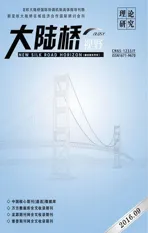Literature Review on Context Translation Mode
2016-12-27褚杨杨华北理工大学
褚杨杨/华北理工大学
Literature Review on Context Translation Mode
褚杨杨/华北理工大学
The theory context translation m ode a new theory concerning context involves three dim ensions including com m unicative dim ension, pragm atic dim ension and sem iotic dim ension. This paper aim s to explain the progress of its developm ent.
context translation m ode; literature review; developm ent progress
1.register theory
Halliday firstly put forward the concept, register, which was seen as a recurrent “situation type,” which is essentially a “semiotic structure,” a configuration of “meanings deriving from the semiotic system that constitutes the culture” (ibid. : 109). Halliday classified the register to three headings: field, mode and tenor to describe how the situation determines the meanings that are expressed. Three concepts are explained: field, mode and tenor. Field is the total event, in which the text is functioning together with the purposive activity of the speaker or writer. The mode is the function of the text in the event,. The tenor refers to the type of role interaction. Field, mode and tenor collectively define the context of situation of a text.(Halliday and Hasan, 2001:22)
2.Context Translation Mode
Hatim and Mason (2001:56) questioned the theory that register can reflect all meanings of context. They held that “a lot more than this (register), however, is retorted to by language users in handling context and in tracing the ways it is reflected in actual textual material. For translators, the relevant questions are: 1. Does translating activity consist solely of matching source language (hereafter “SL”) and target language (hereafter “TL”) register in accordance with intuitively perceived or externally defined ‘stylistic’ conventions?2. Can text be reduced to compilations of situational variables, recognition of which is sufficient to establish equivalence?” It can be seen from the two questions, that they have doubts on the gaining means of three variables. That is to say, the intuitively perceived or externally defined source text situation may be not that author’s situation, and the accumulation of uncertain variables are not enough to ensure the situation equivalence between source text and target text. It is feasible to master the marocontext via the register theory, but the defect is that it is difficult to present the dynamic situation in micro linguistic context (such as, phrase and sentence). Based on this, Hatim and Mason put forward another two dimensions to make up for the deficiency of register theory, namely, pragmatic dimension and semiotic dimension.
Pragmatic dimension is the ability to perform actions. Pragmatic has been defined as the study of the relations between language and its context of utterance. Stalnaker (1972:380) offers more helpful definition: pragmatic is the study of the purposes for which sentences are used, of the real world conditions under which a sentence may be approximately used as an utterance. It was the Oxford philosopher J. Austin (1962) who first investigates the ability of sentences to perform actions, to affect some communicative purpose over and above the sense conveyed by the sum of the individual lexical items which the sentence comprises. Austin distinguished three different kinds of actions which are performed when a language user produces an utterance: locutionary act, the action performed by uttering a well-formed, meaningful sentence; illocutionary act, the communicative force which accompanies the utterance, e.g. promising, warning, conceding, denying, etc; perlocutionary act, the effect of the utterance on the hearer/reader. These three acts are called speech act theory. In fact, illocutionary force offers the discourse communicative abilities. Texts are comprised by a bunch of speech acts. It is necessary to analyze the non-language factors for understanding every speech act implication. In translation process, translators should consider the meaning of speech act from the aspect of pragmatic dimension, so as to make the same context effect in the target texts.
In addition to Austen’s speech act theory, cooperative principles and conversational implicature are useful in dynamic context study.
Aiming to “provide a definition of context which is comprehensive enough to account for the complexity of actually occurring texts”, Hatim and Mason(2001:101) developed an argument which rests on two basic premises. Firstly, lexical and syntactic choices made within the field (mode, tenor, etc.) of a given discourse are ultimately determined by pragmatic consideration to do with the purposes of utterance, realworld conditions, and soon. Secondly, in order to perceive the full communicative thrust of an utterance, we need to appreciate not only the pragmatic action, but also a semiotic dimension which regulates the interaction of various discousal elements as ‘signs’. Semiotics focuses on what signs are, how they come into being and wear off, and what governs their interaction. (Jakobson, 1970:98)
Later the three dimensions, including communicative, pragmatic, and semiotic one are termed as context translation mode by Liu Junping. The communicative dimension includes language use variation (register) and language user’s variation (dialect).
3、Conclusion
To sum up, the context translation mode put forward by Hatim and Mason is of great significance in translation, since it is comprehensive enough to account for the complexity of actually occurring texts.
Reference:
[1] Austin. J. L. How to do Things with Words. Cambridge, Mass.: Harvard University Press, 1962.
[2] Halliday & Hasan. Cohesion in English [M].Beijing: Foreign Language Teaching and Research Press, 2001.
[3] Hatim, B. & Mason, I. Discourse and the Translator. Shanghai: Shanghai Foreign Language Education Press, 2001.
[4] Jakobson, R. In Main Trends in the Science of Language. London: George Allen and Unwin Ltd, 1970.
[5] Stalnaker, R.C‘. Pragmatic’, in D. Davidson and G.Harman(eds), Semantics of Natural Language. Dordrecht:Reidel, 1972.
